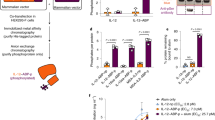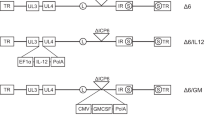Abstract
The recent use of interleukin 2 (IL-2) and interleukin 4 (IL-4) single cytokine modified tumour cells in rodent models has demonstrated a potential use of these cytokines to produce autologous cancer cell vaccines. Here we compare the potential therapeutic benefit of transduction with IL-2 or IL-4 alone, and combined IL-2 + IL-4 in B16F10 cells, a murine malignant melanoma of poor immunogenicity. Transduction of B16F10 cells (MHC class I and II negative) to express either IL-2 or IL-4 alone delays the formation of tumours, IL-4 being more effective than IL-2. However, combined expression of IL-2 + IL-4 reduces tumorigenicity more than either cytokine alone. The eventual formation of tumours may result from loss of gene expression, and preliminary results suggest methylation of the retroviral long terminal repeat (LTR), rather than loss of the transduced DNA sequences. Histological examination of tumours expressing either IL-2 or IL-4 alone shows a non-specific inflammatory reaction with an increased tissue infiltrate of immune effectors (monocytes/macrophages, lymphocytes, granulocytes) localised around the tumour. In comparison, when cells expressing combined IL-2 + IL-4 were injected there were more granulocytes present, and perhaps more importantly, these were mainly localised within the tumour. The benefit of combined IL-2 + IL-4 expression results from a local rather than systemic effect as the growth of tumours from cells expressing IL-2 or IL-4 alone injected at distant sites was comparable with a single inoculation of cells expressing either cytokine alone. However, when cells expressing single cytokines IL-2 or IL-4 were mixed and injected at the same site, in comparison with the clonal population of cells expressing combined IL-2 + IL-4, tumour growth was characteristic of IL-4 alone rather than IL-2 + IL-4. Treatment of established tumours with a single injection of lethally irradiated tumour cells expressing IL-2 + IL-4 was sufficient to either reject tumours, or at least delay further tumour development. Furthermore, treatment stimulated an initial non-specific immune reaction that lead to a systemic immunity. Lethally irradiated wild-type cells were also successful in treating some established tumours, although this did not induce any systemic immunity. However, although successful in treatment studies, neither wild-type nor combined IL-2 + IL-4 expressing cells were able to vaccinate animals against a subsequent challenge with live wild-type tumour. These results indicate a potential therapeutic benefit with the use of combination IL-2 + IL-4 transduction of autologous cancer cells.
This is a preview of subscription content, access via your institution
Access options
Subscribe to this journal
Receive 24 print issues and online access
$259.00 per year
only $10.79 per issue
Buy this article
- Purchase on Springer Link
- Instant access to full article PDF
Prices may be subject to local taxes which are calculated during checkout
Similar content being viewed by others
Author information
Authors and Affiliations
Rights and permissions
About this article
Cite this article
Hollingsworth, S., Darling, D., Gäken, J. et al. The effect of combined expression of interleukin 2 and interleukin 4 on the tumorigenicity and treatment of B16F10 melanoma. Br J Cancer 74, 6–15 (1996). https://doi.org/10.1038/bjc.1996.308
Issue Date:
DOI: https://doi.org/10.1038/bjc.1996.308
This article is cited by
-
Therapy of lung metastases through combined vaccination with carcinoma cells engineered to release IL-13 and IFN-γ
Gene Therapy (2001)
-
Endothelial cell–based systemic gene therapy of metastatic melanoma
Cancer Gene Therapy (2001)
-
Fusagene vectors: a novel strategy for the expression of multiple genes from a single cistron
Gene Therapy (2000)
-
Recent Advances in the Treatment of Malignant Melanoma with Gene Therapy
Molecular Medicine (1997)



